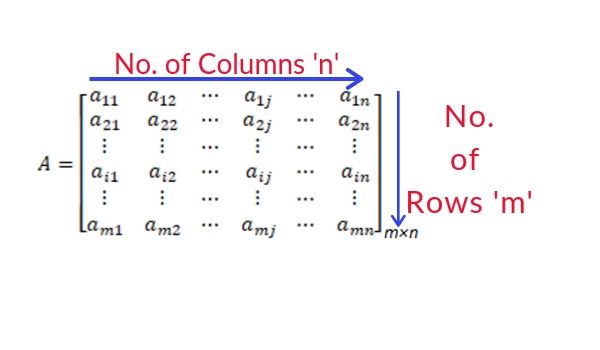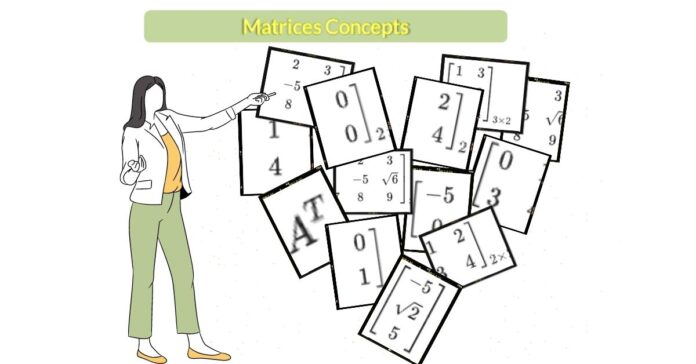Matrices concept knowledge is most important in mathematics. It made simplification of linear equations easy. Matrices have major applications in a wide range like it is used in spreadsheet programs, in business areas and science that is in budgeting, sales, cost estimation and also in sociology, psychology, etc. Introducing of the matrices tool helped in solving algebraic problems very easily. Let’s first understand the concept of matrices and then their application in algebra.
Matrices Definition in Matrices Concept Basics
Matrices are an ordered rectangular array consisting of numbers or functions or elements represented in rows and columns.
\begin{align*}
A=\begin{bmatrix} -3 & 4 \\ 5 & 6 \\ 7 & -8 \end{bmatrix} \ \\ \\ B=\begin{bmatrix} 1+y & y^{2} & 2 & \\ sin x & cosx & \tan x \end{bmatrix}
\end{align*}
Row Elements or Rows
The elements represented in a horizontal line inside the matrix comes under rows.
Column Elements or Columns
The elements represented in a vertical line inside the matrix comes under columns.
Order of Matrices
Any matrix consisting of m rows and n columns is represented in the order m×n. This m×n is called order of the matrix and the matrix can be called as m×n matrix.
Order of a matricx can be represented as number of rows × number of columns
Representation of m×n Matrices in Matrices Concept


The above matrix consists of ‘m’ rows and ‘n’ columns.
Simply matrix can be represented as A=[aij]m×n where 1≤i≤m, 1≤j≤n i,j ∈ N
‘i’ indicates row elements number and elements in ith row are represented as ai1, ai2, ai3………..ain.
‘j’ indicates row elements number and elements in jth row are represented as a1j, a2j, a3j………..amj.
aij is the element whose poaition in matrix is ith row and jth column.
Examples for Representation of Matrices for different Orders
\begin{align*}
\begin{aligned}A=\begin{bmatrix} 1 & 2 \\ 3 & 4 \end{bmatrix} _{2\times 2} \ \end{aligned} \end{align*}
\begin{align*}
\begin{aligned}B=\begin{bmatrix} 1 & 3 & 0 & 4 \\ 2 & -1 & 1 & 6 \end{bmatrix} _{2\times 4} \end{aligned} \end{align*}
\begin{align*}
\begin{aligned}C=\begin{bmatrix} 1 & 3 \\ 7 & 9 \\ 0 & 4 \end{bmatrix} _{3\times 2} \\ \\ \\ D=\begin{bmatrix} 1 \\ 2 \\ 3 \end{bmatrix} _{3\times 1} \ \ E=\begin{bmatrix} 1&2 & 3 \end{bmatrix} _{1\times 3} \end{aligned}
\end{align*}
Types of Matrices
Row Matrix
A matrix which consists of elements in only one row is a row matrix.
Example:
A=[-5 3 2 ]
‘A’ is a row matrix of order 1×4.
Column Matix
A matrix that consists of elements in only one column is a column matrix.
Example:
\begin{align*}
B=\begin{bmatrix} -5 \\ \sqrt {2} \\ 5 \end{bmatrix}
\end{align*}
‘B’ is a column matrix of order 3 × 1
Square Matrix
A matrix that has a same number of rows and columns is a square matrix.
Example:
A matrix of order m × n is said to be a square matrix if m=n and is represented as order m × m or n × n
i,e A=[aij]m×m or A=[aij]n×n
\begin{align*}
A=\begin{bmatrix} 1 & 2 & 3 \\ 4 & -5 & \sqrt {6} \\ -7 & 8 & 9 \end{bmatrix}_{3\times 3}
\end{align*}
‘A’ is square matrix of order 3 × 3.
Diagonal Matrix
If non-diagonal elements of a square matrix are zero then that matrix is a diagonal matrix.
A=[aij]m×m is said to be diagonal matrix if aij =0, where i ≠ j
Example:
\begin{align*}
A=\begin{bmatrix} -2 & 0 & 0 \\ 0 & 3 & 0 \\ 0 & 0 & \sqrt {2} \end{bmatrix}_{3\times 3}
\end{align*}
Scalar Matrix
A diagonal matrix with all its diagonal elements equal is a scalar matrix.
A=[aij]m×m is said to be a scalar matrix
if aij =0 where i ≠ j
aij =k where i=j, k is any value.
Example:
\begin{align*}
A=\begin{bmatrix} \sqrt {2} & 0 & 0 \\ 0 & \sqrt {2} & 0 \\ 0 & 0 & \sqrt {2} \end{bmatrix}_{3\times 3} \ \\ \\ B=\begin{bmatrix} -5 & 0 \\ 0 & -5 \end{bmatrix}_{2\times 2}
\end{align*}
Identity Matrix
A diagonal matrix with all its diagonal elements equal to 1 is an identity matrix.
Represented as In or simply I. Here ‘n’ is the order of identity matrix.
In = [aij]n×n where aij =0 if i ≠ j aij =1 if i=j,
\begin{align*}
A=\begin{bmatrix} 1 & 0 & 0 \\ 0 & 1 & 0 \\ 0 & 0 & 1 \end{bmatrix}_{3\times 3} \ \ \ B=\begin{bmatrix} 1 & 0 \\ 0 & 1 \end{bmatrix}_{2\times 2}
\end{align*}
NOTE:
1. Every identiy matrix is a scalar matrix.
2. A singular matrix with k=1 is an identity matrix.
Zero Matrix
A matrix with all its elements as zero is called a zero matrix or null matrix.
Represented as O= [Oij]m×n
Example:
\begin{align*}
A=\begin{bmatrix} 0 & 0 & 0 \\ 0 & 0 & 0 \\ 0 & 0 & 0 \end{bmatrix}_{3\times 3} \ \ \ B=\begin{bmatrix} 0 & 0 \\ 0 & 0 \end{bmatrix}_{2\times 2}
\end{align*}
Transpose of a Matrix
A matrix formed by interchanging the rows and columns of a matrix [aij]m×n is called transpose of matrix [aij]m×n . It is represented by AT or A| .
Let A= [aij]m×n then, AT =[aij]n×m
Example:
\begin{align*}
A=\begin{bmatrix} 0 & 1 & 2 \\ 3 & 4 & 5 \end{bmatrix} \ then \ A^{T}=\begin{bmatrix} 0& 3 \\ 1 & 4 \\ 2 & 5 \end{bmatrix}
\end{align*}
Symmetric Matrix
If transpose of a matrix [aij]m×n is equal to the matrix itself then it is a symmetric matrix.
That is AT=A ⇒ [aij] = [aji]
for all i & j \begin{align*}
A=\begin{bmatrix} 1 & \sqrt{2} & 3 \\ \sqrt{2} & -5 & 4 \\ 3 & 4 & 1 \end{bmatrix}_{3\times 3} \\ \\ is \ a \ symmetric \ matrix
\end{align*}
Skew Symmetric Matrix
If transpose of a given matrix is equal to the additive identity of that matrix then the matrix is skew symmetric matrix.
That is AT= -A ⇒ [aij] = – [aji]
if i=j then aii = aii
⇒ 2 aii =0
⇒ aii =0 For all ‘i’ values.
Therefore, Diagonal elements of a skew-symmetric matrix are zero’s.
Example:
\begin{align*}
A=\begin{bmatrix} 0 & 1 & 2 \\ 1 & 0 & -4 \\ 2 & -4 & 0 \end{bmatrix}_{3\times 3} \\ \\ is \ a \ skew-symmetric \ matrix
\end{align*}
NOTE:
- ‘A’ is a square matrix
then A+AT is a symmetric matrix and
A-AT is a skew-symmetric matrix. - Any square matrix can be represented as sum of a symmetric and a skew-symmetric matrix.
A= ½(A+AT) + ½(A-AT)







